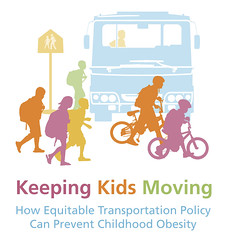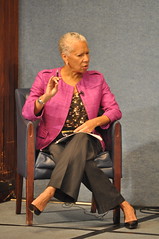
News
By Barbara McCann, July 21, 2010
 A lively conversation is underway on how transportation policy affects low income and minority children – and what can be done about it. A coalition of "unusual suspects" met in Washington DC, convened by Coalition partners PolicyLink and Transportation for America, along with the Robert Wood Johnson Foundation’s Center to Prevent Childhood Obesity and the Convergence Project.
A lively conversation is underway on how transportation policy affects low income and minority children – and what can be done about it. A coalition of "unusual suspects" met in Washington DC, convened by Coalition partners PolicyLink and Transportation for America, along with the Robert Wood Johnson Foundation’s Center to Prevent Childhood Obesity and the Convergence Project.
As speaker after speaker noted the growing prevalence of overweight and obesity among children, especially children of color, and the lack of opportunities for physical activity and healthy eating, Angela Glover-Blackwell of PolicyLink noted, "I worry that we will address this problem in ways that will make us feel good, but will continue to leave people behind."
The Complete Streets movement has a role to play in ensuring no one is left behind. We work for policies that make sure that transportation planners take into account the needs of everyone using the road – and that includes low income and minority children. But how can we create a sharper focus on these needs?

For these children, the most fundamental need Complete Streets can address is safety. As pointed out in an excellent new report from Coalition Steering Committee member the Safe Routes to School National Partnership (SRTS NP), children from low-income households have a higher risk of being injured or killed as pedestrians. Their neighborhoods may have suffered from a lack of attention to the pedestrian environment – and a study by a Harvard researcher found that lower-income counties were less likely to use federal transportation dollars on bicycle and pedestrian projects. Complete Streets policies can ensure that transportation planners pay attention to these needs, even in neighborhoods that don’t have the clout to seek special funding for special projects.
When equity advocates talk about safety, they are just as often talking about safety from violence. A new report by the Prevention Institute finds that the threat of violence causes people to be less physically active and leaves them reluctant to walk in their own neighborhoods. One study cited by SRTS NP found that 19% of children fear being attacked on the way to or from school. How can Complete Streets help address this broad social problem? Most obviously, communities implementing Complete Streets policies can involve law enforcement in transportation planning – for example, police may be able to help identify streets that need more lighting.
But the more profound effect of Complete Streets may be in creating a street environment that says to children: "you belong here." As discussed in the Prevention Institute report, the neglect of public environments conveys the message that no one really cares – and this is certainly the message conveyed to a child (and their parents) by a busy street without sidewalks or crosswalks. As residents avoid such uninviting public spaces, gang members or criminals may take over.

A Complete Streets policy can help a community end the neglect and prioritize the needs of children for a safe travel environment. As the physical environment becomes safer and more inviting, more children and adults will be out walking and bicycling, reclaiming community space. Research shows that safety in numbers applies both to crime and to traffic crashes. A great example of this approach is in Chicago, where the city’s Complete Streets policy is explicit about providing for the most vulnerable citizens, and where the Active Transportation Alliance runs a "Better Blocks" program aimed at working with communities to improve the street environment.
As Glover-Blackwell noted at the forum, installing curb ramps for Americans with disabilities didn’t just help them – it helped everyone with a rolling suitcase or stroller. Solving the problem with a focus on the most vulnerable is a sure way to avoid leaving anyone behind.
You can also join the conversation – the Robert Wood Johnson Foundation is inviting suggestions to help them flesh out their six policy recommendations for reversing the childhood obesity epidemic. They've created an online forum that will be open over the next two weeks. Be sure to visit the fourth policy priority, "Increase physical activity by improving the built environment in communities."
Related News

© 2025 Smart Growth America. All rights reserved
Site By3Lane Marketing












